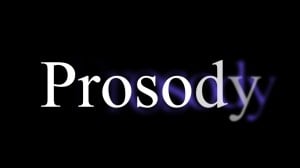Prosody: Singing While You Speak
 The word Prosody comes from the Greek prosoidia, part pros- “toward” and part oide “song.” Don’t be misled into thinking that it only represents song; it actually refers to all the patterns of stress and intonation in a language that give it some very important characteristics.
The word Prosody comes from the Greek prosoidia, part pros- “toward” and part oide “song.” Don’t be misled into thinking that it only represents song; it actually refers to all the patterns of stress and intonation in a language that give it some very important characteristics.
Speaking with a good grasp of prosody is to speak with expression, when you listen to someone talk ‘passionately’ or rather ‘dull,’ it’s generally due to their use of (or lack thereof) prosody.
It’s recommended children learn the fundamentals of prosody between ages 6 – 10 by reading aloud and with expression; there is a strong link between this and a child’s general proficiency at reading. When reading aloud, a child can show good prosody when they naturally respond to the features of the writing; such as pausing slightly at commas, raising their pitch at the end of a question, and lowering their pitch at the end of declarative sentences.
 For children reading aloud, the prosody can also be a good reflection of their reading comprehension; when a person reads they must first decode individual words and if they struggle to do that, they will tend to pause too long and too frequently, leaving little mental resources for conveying expression.
For children reading aloud, the prosody can also be a good reflection of their reading comprehension; when a person reads they must first decode individual words and if they struggle to do that, they will tend to pause too long and too frequently, leaving little mental resources for conveying expression.
You might think this is just good punctuation: well, that’s partly correct, but there’s more at play here. One can follow the rules of punctuation by pausing at all the commas and rests, even though the sentence does not call for it, such as when a comma is used to separate items: “I’m eating my pancakes with syrup, blueberries, banana and cream.” When you read that I doubt you’ll pause for as long as the comma I put right here, because there’s no need to.
 I mentioned in a previous post how intonation can greatly influence what you’re saying. The exact example was “She said I kicked her dog?” or “She said I kicked her dog?” and how by placing the accent on the highlighted words you’re asking a different question, even though the grammar and structure are the same. Intonation is one part of prosody, but there are other aspects too, such as tune, rhythm, word choices, emphasis, and pauses. Using these in different combinations gives off different meanings: it’s the way in which we can say something sarcastically or in irony, how we allude to an emotion, and form questions or commands.To put it simply, with no prosody, you sound like a robot. Unfortunately it’s a rather difficult aspect to teach.Generally it will be picked up naturally when there is a good grasp of punctuation and therefore time and mental resources left for expressing the emotion.
I mentioned in a previous post how intonation can greatly influence what you’re saying. The exact example was “She said I kicked her dog?” or “She said I kicked her dog?” and how by placing the accent on the highlighted words you’re asking a different question, even though the grammar and structure are the same. Intonation is one part of prosody, but there are other aspects too, such as tune, rhythm, word choices, emphasis, and pauses. Using these in different combinations gives off different meanings: it’s the way in which we can say something sarcastically or in irony, how we allude to an emotion, and form questions or commands.To put it simply, with no prosody, you sound like a robot. Unfortunately it’s a rather difficult aspect to teach.Generally it will be picked up naturally when there is a good grasp of punctuation and therefore time and mental resources left for expressing the emotion.
Do you use much expression when talking? Can you see link between prosody and poetry or singing?
